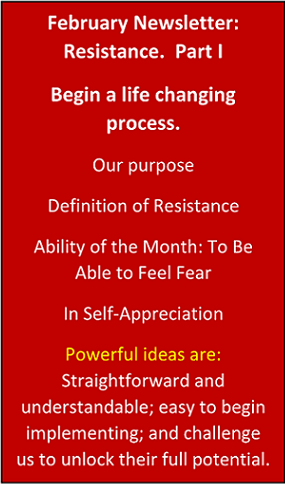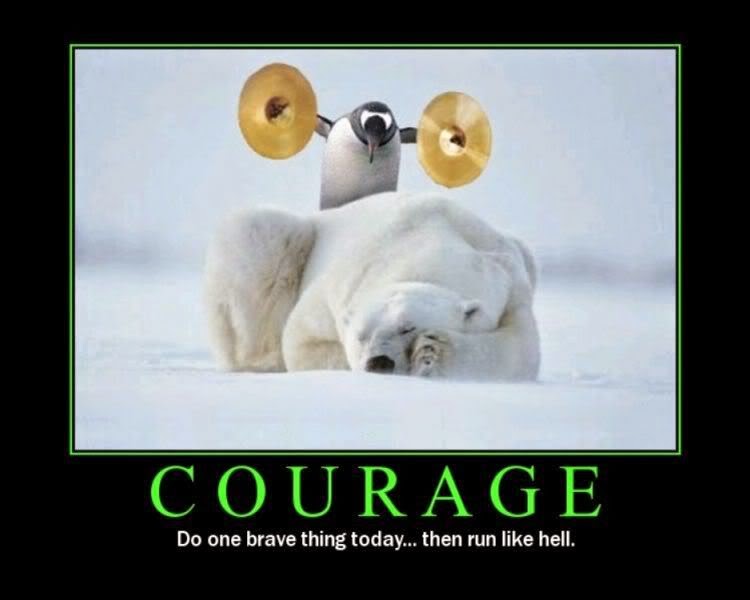
Resistance: The Blockage that Keeps Us from Being, Doing, and Having What We Want. Part I PDF version
In the northern hemisphere, February finds us in the middle of winter. If you live in the southern hemisphere you may not be experiencing winter, but you know what winter is. Winter can be a natural time for hibernation, getting extra sleep.
Our Purpose
January may have brought New Year’s resolutions and goals for the upcoming year. Whether our goals are clearly stated or are vague hopes for a better future, we are anticipating change. Whenever we see change coming (positive or negative) resistance kicks in as a natural and inevitable reaction. Let’s explore what resistance is. This will alert you and help you recognize what you might be up against as you seek positive change for yourself in 2017, and beyond.
In part II of the newsletter (March) we will explore what it takes to deal with and to resolve resistance once we have recognized it.
Resistance: Definition
Resistance is anything that keeps movement from starting or slows it down once it has started. Since change is movement, resistance is natural part of the process of change. (Without resistance, changes that we initiate would never stop. They would function like a runaway train.)
changes that we initiate would never stop. They would function like a runaway train.)
In our thinking, resistance takes the form of “the reasons why not”. These thoughts can be relatively simple thoughts or be comprised of complex belief systems. For example, “I do not want to earn more money because I will have to pay higher taxes.” In our feelings, resistance expresses fear. “I am afraid of having to pay higher taxes because I will feel exploited and my rage (which I don’t want to face because I am afraid of it) about exploitation will come out.” Then there is a conclusion, “Therefore, it is better (safer) not to earn more money.” We are usually unaware of the thinking, the feeling, and the concluding, of resistance.
Recognizing Resistance
To recognize resistance, we must become aware of resistance type thoughts, feelings, and behavior that are not leading us in the direction of a change that we want to make. Becoming aware of our feelings can be easy or hard depending on the intensity of the feeling. Though the predominant feeling that we must face is fear, there may be other feelings, like anxiety or “stress”, present. Facing our fear, and other feelings, takes courage.
(Click here for a list of our resistances to goal setting.)
Practice: Take some time to recognize (and write down) your resistance thoughts, feelings and behavior.
Fear
Our feelings have messages for us. The message of fear is that we are perceiving a situation of danger. Our first (instinctual) reaction is to run from danger, which is an adaptive response to physical danger (the tiger chasing us). However, as most of the dangers we face are emotional, mental, or social, ‘running away’ or avoidance, will not lead us to dealing with a fearful situation. In order to overcome our fears we need to face them. This is fundamental. No feeling that is avoided ever goes away. We also need to develop the skill of interpreting the messages of our feelings. The message may be an accurate perception or may contain some misperceptions. To work with our perceptions we need to tune into the thoughts that accompany the feelings.
danger. Our first (instinctual) reaction is to run from danger, which is an adaptive response to physical danger (the tiger chasing us). However, as most of the dangers we face are emotional, mental, or social, ‘running away’ or avoidance, will not lead us to dealing with a fearful situation. In order to overcome our fears we need to face them. This is fundamental. No feeling that is avoided ever goes away. We also need to develop the skill of interpreting the messages of our feelings. The message may be an accurate perception or may contain some misperceptions. To work with our perceptions we need to tune into the thoughts that accompany the feelings.
We will see that resolving resistance also involves challenging and changing our thinking. We need courage to take on this challenge and to make the changes that are necessary to overcome resistance.
(Further reading—The Operating Manual for the Self: thinking distortions, feelings, emotions, and defense mechanisms)
We may find obstacles in our way that take courage to overcome.

Ability of the Month: To Be Able to Feel Fear
This may not seem like something to value and celebrate until we look at what fear does for us. It alerts us to a situation that threatens our human needs. (Our needs: Survival, safe/security, belonging/loving, self-esteem, to create/produce/know, self-actualization, and beauty/mystery/transcendence.) Once alerted we can take steps of effectively deal with this situation by removing the threat.

“Do one brave thing today…then run like hell.”
Is this courage? Maybe not, but it makes us laugh.
In Self-appreciation
When you recognize your resistance and feel afraid:
- Be kind and compassionate toward yourself.
- Empathize with yourself.
- Share what you are going through with a sympathetic, empathic and supportive person.
- Persist
Next month we will identify the sources of courage and identify exactly what to do to resolve resistance.

Want strategies and inspiration
to tackle your resistance?
Consult The Operating Manual for the Self
Let’s unite in developing our human potential. Share this newsletter with others. Please visit our website, IIFSD.org. We invite you to participate, (as suggested in the Participation Menu selection). When you buy The Operating Manual for the Self (manualfortheself.com), you support our vision and mission. When you read The Operating Manual for the Self, you leap forward in your personal self-development and evolution.
Copywrite IIFSD.org, 2017. All rights reserved.
